You can read about a place. You can look at pictures of it. But unless you’ve been there, dove it and felt it, it’s not the same. For some Tulum is a region of ancient civilization and crumbling ruins, for others, it’s one of the best cave and cenote diving places in the world.
Not all dives in Mexico happen in the salty sea. Some places offer scuba diving, which is several shades darker and way more extreme.
Cenotes are diving locations that every aquaholic dream’s of making pilgrimage someday. Nothing beats the adrenaline-pumping feeling of getting into your dive gear, strapping on a tank and hitting the enclosed clear spring water that makes up these underground water systems.
Cenotes, pronounced say-NOH-tay, are natural pits or sinkholes developed millions of years ago from a combination of geologic occurrence and climate change. These events resulted in the collapse of the limestone bedrock exposing the groundwater below. Some cenotes are vertical water filled-shafts, while others are caves containing pools of water and underground passageways.

The main types of cenotes include:
Open cenotes are the oldest type of cenotes where the cave ceiling has fallen in on itself. They often look like pools or pits surrounded by lush vegetation. Below the waterline, these open cenotes remain part of the underground labyrinth that connects the region aquatically.
Semi-open cenotes are one of the more common caverns to find throughout the Yucatan region. These cenotes have been subjected to erosion over time, changing them from a fully enclosed cave to a partially exposed one.
Cavernous or underground cenotes are the oldest and most intriguing type of cenote. They can be accessed through smaller land level entrances and open up into an enclosed underground pit. In some instances, only experienced divers and guides have visited the harder to reach underground cenotes.
Millions of years ago, the Yucatan was a giant reef beneath the sea. During the most recent Ice Age, ocean levels dropped, exposing the reef to the surface and causing the coral to die. While vegetation has grown over the coral-turned-limestone platforms creating the dense Mexican jungles we know today, the rivers of groundwater remain. Over time erosion of these sacred pools has created what we know now as cenotes.
The Yucatan Peninsula is famous around the world for its many caves and caverns where the Mayan civilization communicated with the gods. Their existence is as much a defining characteristic of the region, as is guacamole or spicy cuisine.
It is estimated that over 6000 cenotes are spread across the Yucatan Peninsula. Some are easily accessible while the crystal-clear water of others is nestled deep into the jungle. For scuba divers, these windows into Mexico’s subterranean waterways are ideal for cavern and cave diving.
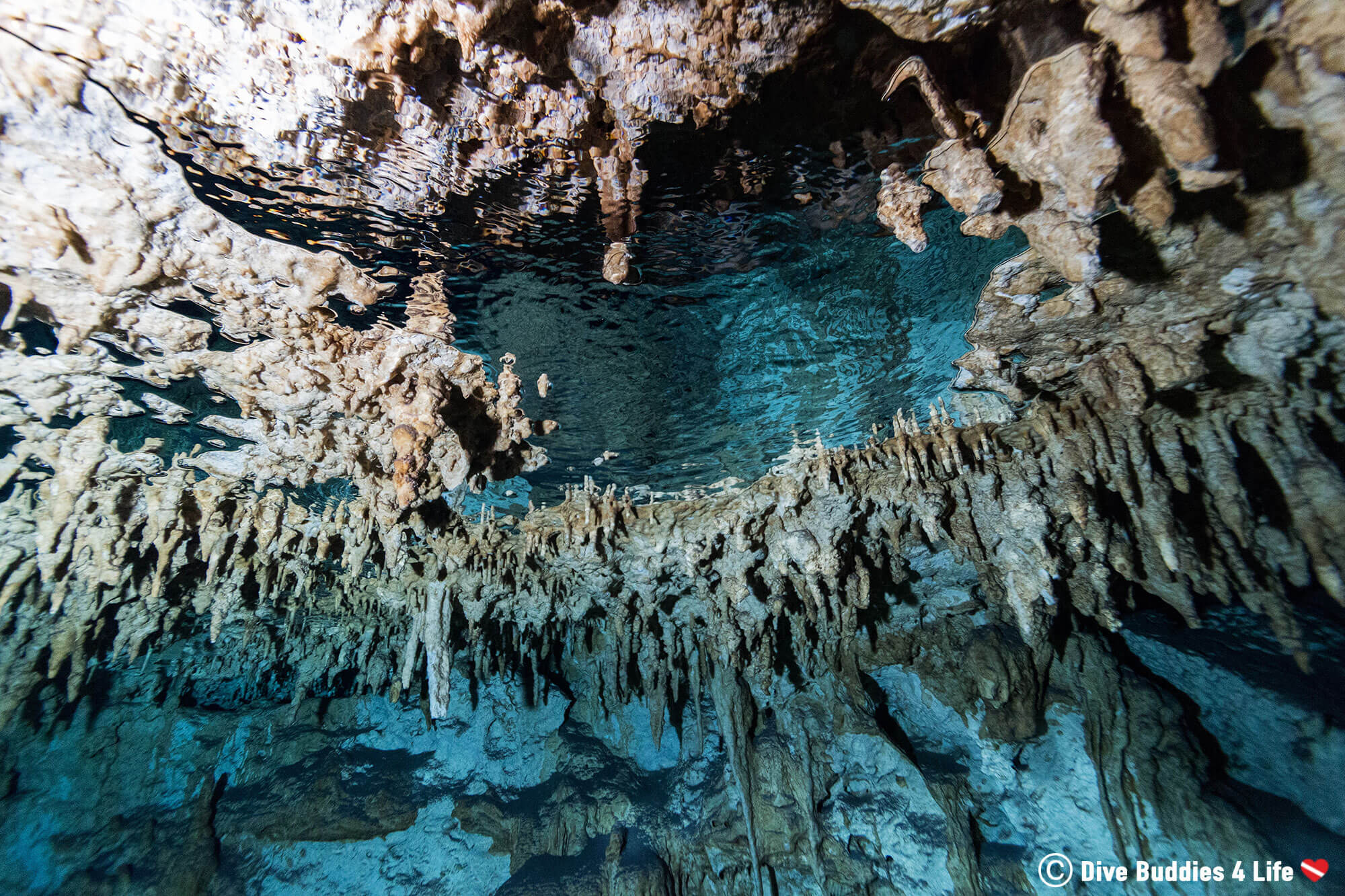
What initially drew Joey and me to Mexico was a place called Tulum, situated in the Quintana Roo province of Mexico, about 2-hours drive from Cancun. Nestled on the Caribbean coast, Tulum is known for its beaches and well-preserved ruins of an ancient Mayan port city.
Waking up to the hustle and bustle on the streets of Tulum, Joey and I assemble our dive gear and head to the parking area of the apartment building. The time is 7 AM sharp, and while I’m not a big morning person, when it comes to scuba diving, there is no such thing as too early.
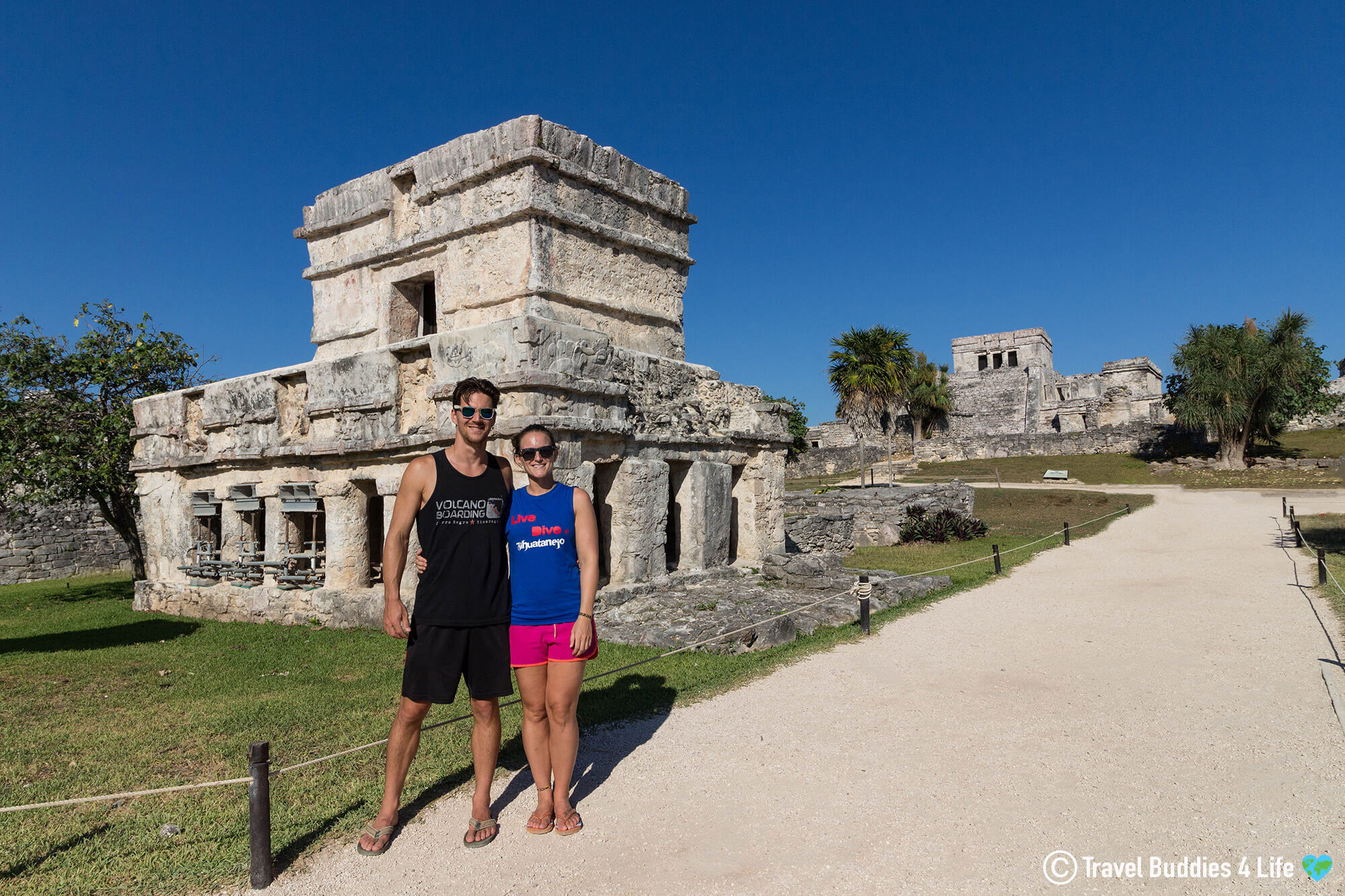
Our first dive of the day brought us a 30-minute drive outside of the city center, to the open cenote of the Pit.
From the surface, the turquoise water of the Pit displayed as an oval-shaped pool in the ground, with steps leading down to the basin. Dive gear on, I step my way down the steep staircase to the platform below.
With a stunning pillar of light beaming from the cave opening right down 30-meters (100-feet) into the glassy water, I was entranced with this cenote from the moment I jumped in the aqua. As one of the deepest cenotes in the area, the Pit is a part of Sistema Dos Ojos, the third-largest underwater cavern system in the world.
Slowly descending into the Pit I could see that the cenote was shaped like a giant cylindrical silo with enough room to fit a jumbo jet in the upper compartment. From the surface, it was deceiving, but underwater the vacant space in this shaft felt genuinely immense.
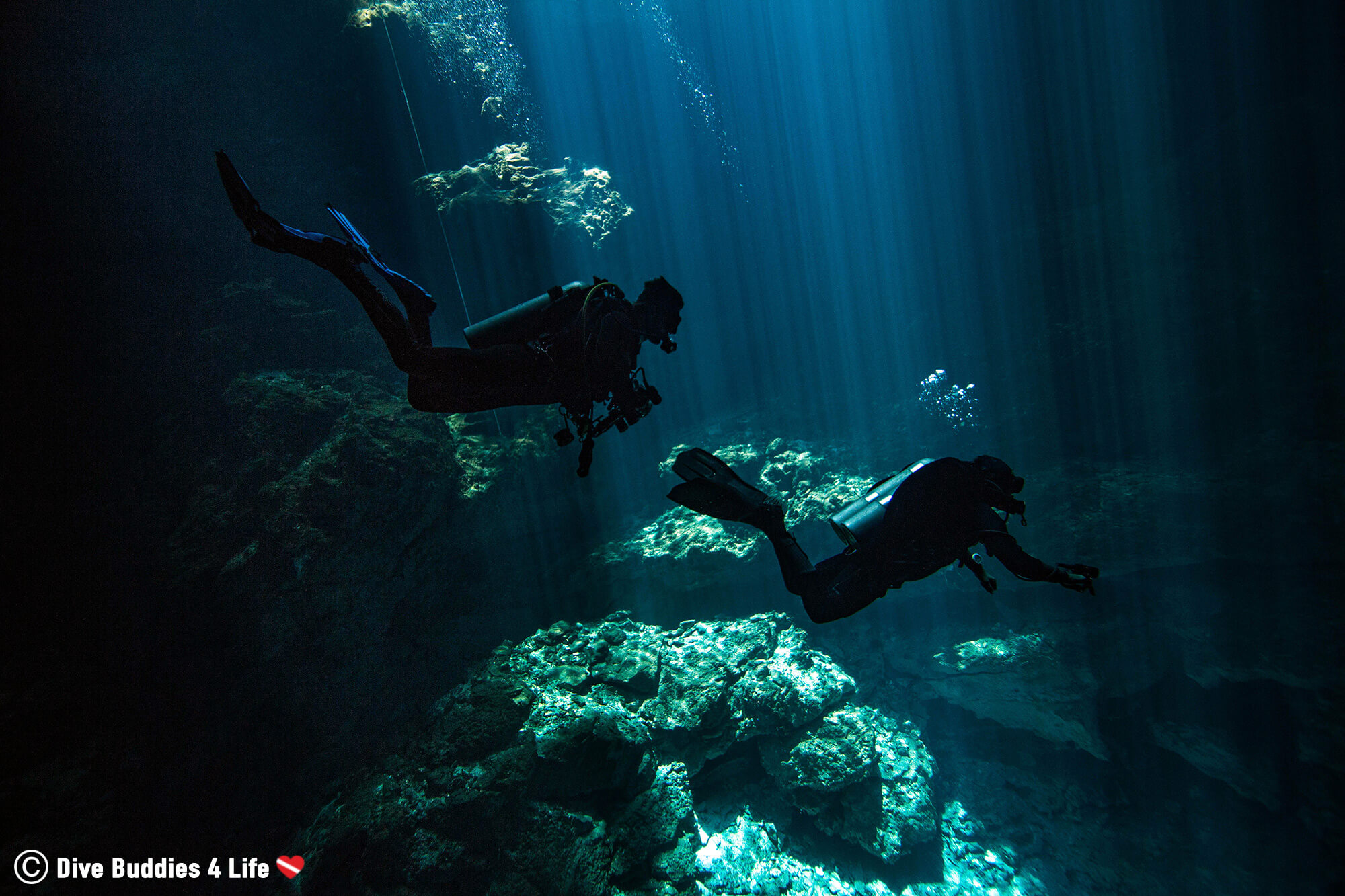
At about 15-meters (50-feet), we penetrated a small halocline layer, where freshwater and saltwater mix. The halocline showed in a brief oily haze breaking apart the uniform column of sunlight and separating the lower part of the cenote from the surface world. It was neat to experience and see this segregation in the water, but made it hard to take pictures, as my camera couldn’t find a focus point.
Below the halocline we continued deeper, reaching a very small cloud of hydrogen sulfide. Passing through the thin white cloud, we hit the deepest part of our dive at about 110 feet.
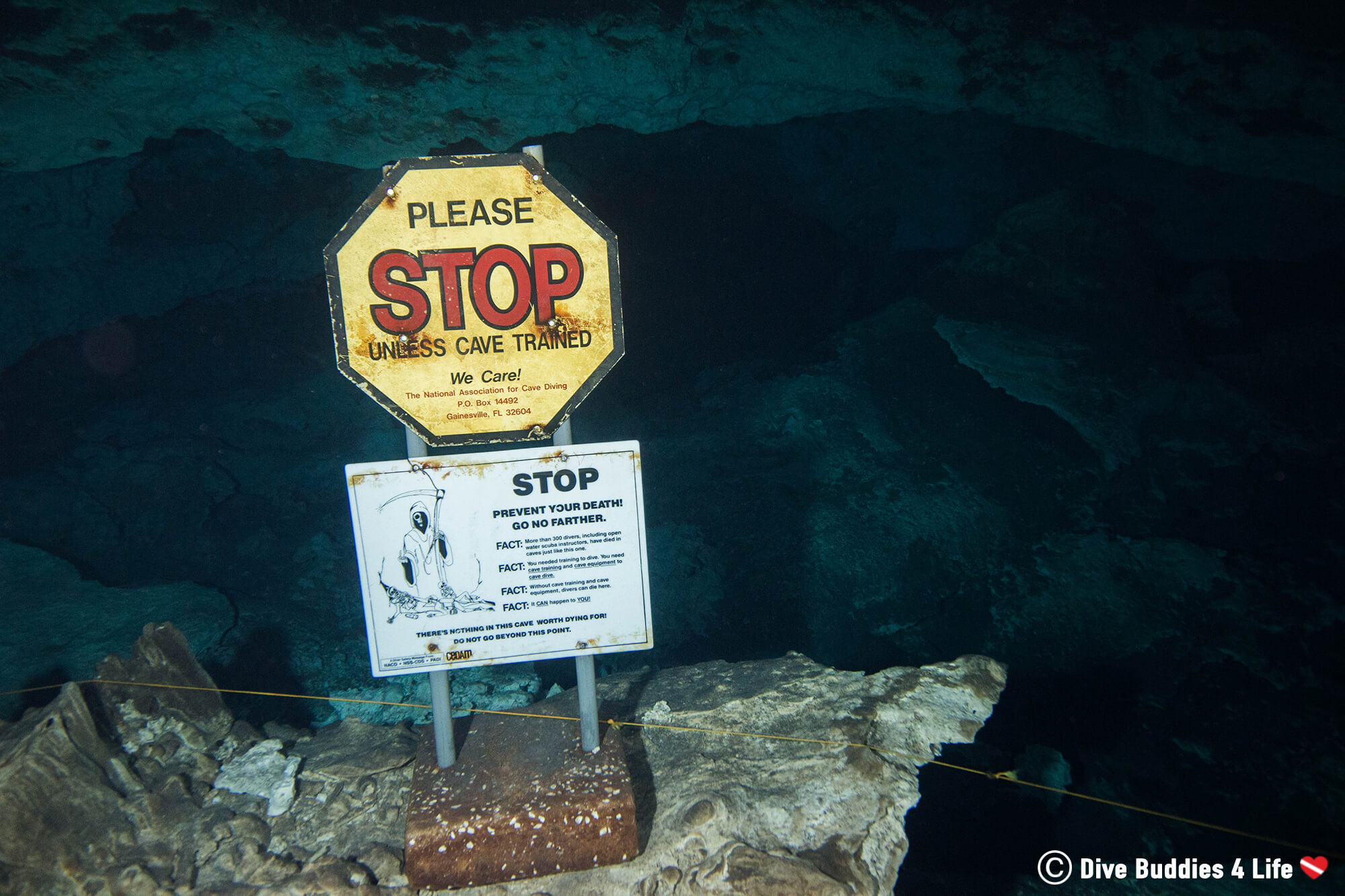
Following the spectacular light show in the Pit, we traveled to our second dive site.
Dos Ojos is a semi-open cenote 22-kilometers north of Tulum on the road leading to Playa del Carmen in Dos Ojos Natural Park. The name Dos Ojos translates to “two eyes” and is meant to describe the two pools of water – one blue and the other dark. The caverns are easily one of the most famous cenotes in the region. Dos Ojos has appeared in multiple documentaries and movies and following our visit, I can honestly understand why. The incredible rock formations coupled with blue water almost looks painted.
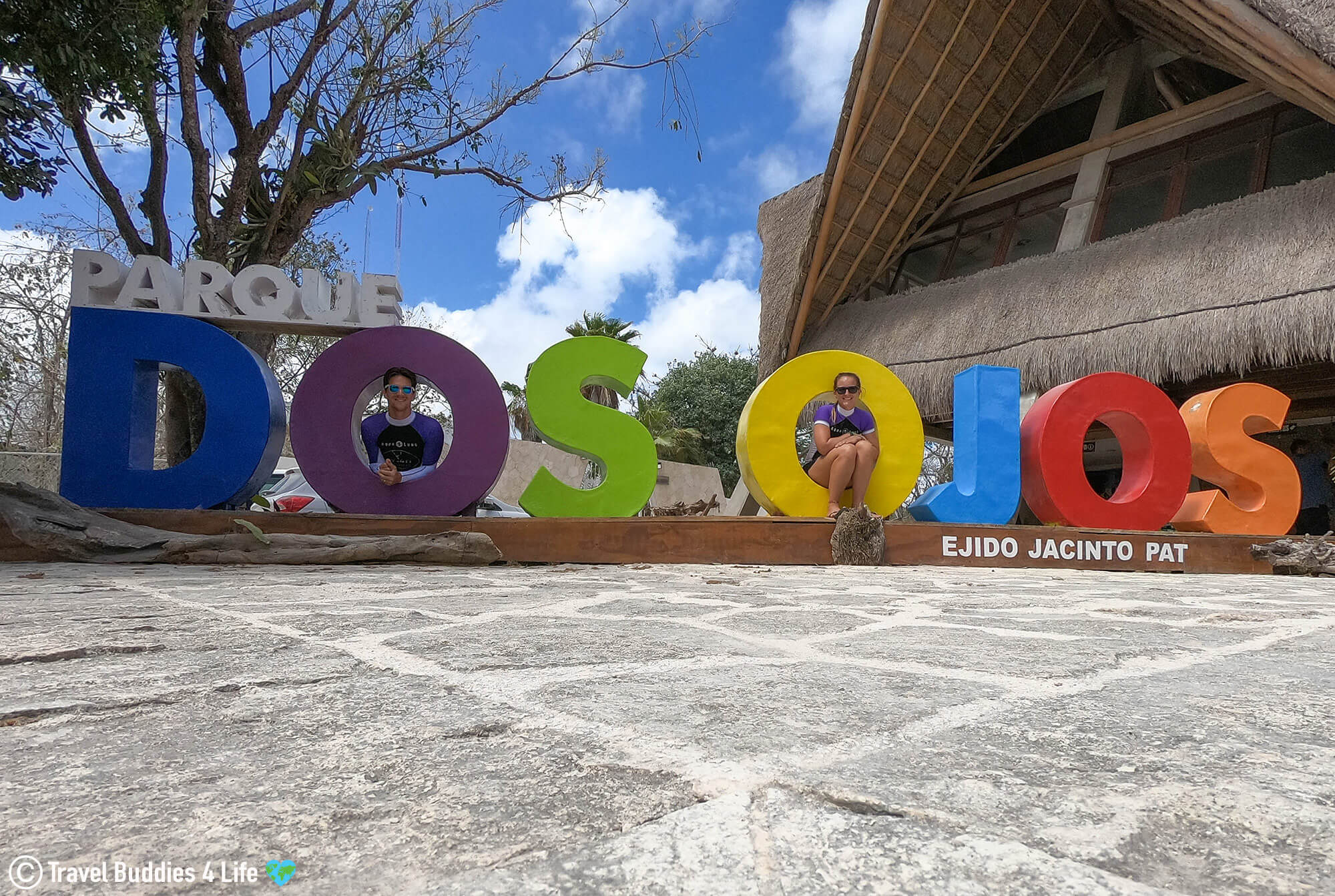
Wading into the mineral-rich waters of Dos Ojos, I prepare myself for submersion into this maze of shallow caverns. Like the Pit, Dos Ojos is connected to the Sistema Dos Ojos cave system. However, unlike its morning counterpart, Dos Ojos is shallow, having a maximum depth of 10-meters (33-feet).
Mask seal over my eyes and regulator clenched in my mouth, a few fleeting fish and skittish shrimp scamper out of our path as we sink into the warm and inviting water.
Because of the semi-enclosed nature of Dos Ojos, at first glance, this cenote has nowhere near the breathtaking light show as the Pit. It has a darker, dingier feel about the water. Dropping down, the immediate bottom of the cave is made of sand, superseded on the edges by limestone rock where the cave opens into the earth. Finning from our entry point into the overhead environment, my senses are heightened as the dark world closes in around me.
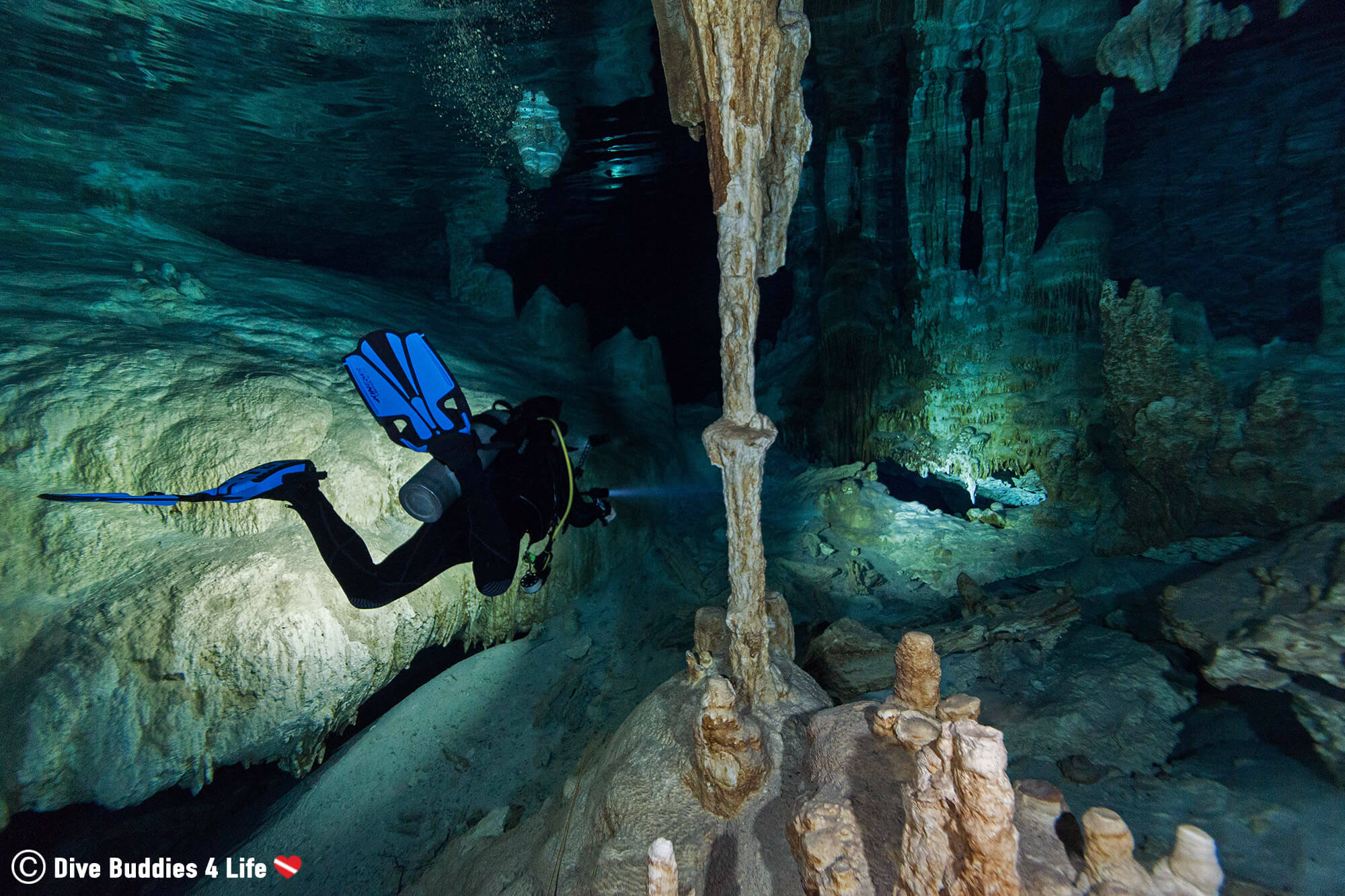
Using the narrow beam of my torch for guidance, I light up the walls and ceiling, revealing Dos Ojos’s hidden beauty. Stalagmites and stalactites hang like icicles dripping from rooftops at Christmas. They are scattered willy-nilly across the cavern for as far, and my dive light would illuminate. Some stalactites taper off to spiky points, while others have joined together with stalagmites over time, creating a thick pillar. As a sucker for underground formations, I was positively entranced by the incredible geology.
Moving my attention from the dripping speleothems formations, I gaze across the somber subterranean tunnel toward the irregular openings in the ceiling. Here sunlight from the surface floods the darkness of Dos Ojos, and to the naked eye, the play of light is wonderous. The sparkling beams of sun dance across the water’s azure surface in a stage performing-like fashion making me want to take a picture, or three… or a dozen.

Our second day of diving began even earlier than the previous one. After a bumpy 15-minute ride southward on the road going to Chetumal, we were the first to arrive at Cenote Angelita.
Gearing up in the back of the dive van, our group walked along a narrow jungle path leading to an open-pit sinkhole. From the surface, Angelita didn’t look like anything more than a swampy frog pool, but underwater this cavern proved to be a much different story.
Descending into the liquid pit was much like descending in an elevator shaft. Angelita was a straight uneventful drop into greenish tinged water, with the sun rays dampening the deeper we went. The cenote plunged to 55 meters (180 feet), but given our recreational certification limits, we stayed within 37 meters (120 feet).
Reaching the 30-meter (100 foot) mark, an eerie hydrogen sulfur cloud created a false bottom to the cenote. This one-of-a-kind effect is considered one of the most notable features of Angelita. The smokey layer was more than 1.5 meters (5 feet) thick and had fresh water on the surface and saltwater down below. The hydrogen sulfur composition was so dense that it masked everything found beneath this foggy cloud.
From the smokey suspension, fallen trees and branches clawed towards the surface like something from a Halloween horror movie. It felt bizarre to swim amid the tree’s brown and blackened limbs, almost as if they had been frozen in time and space.
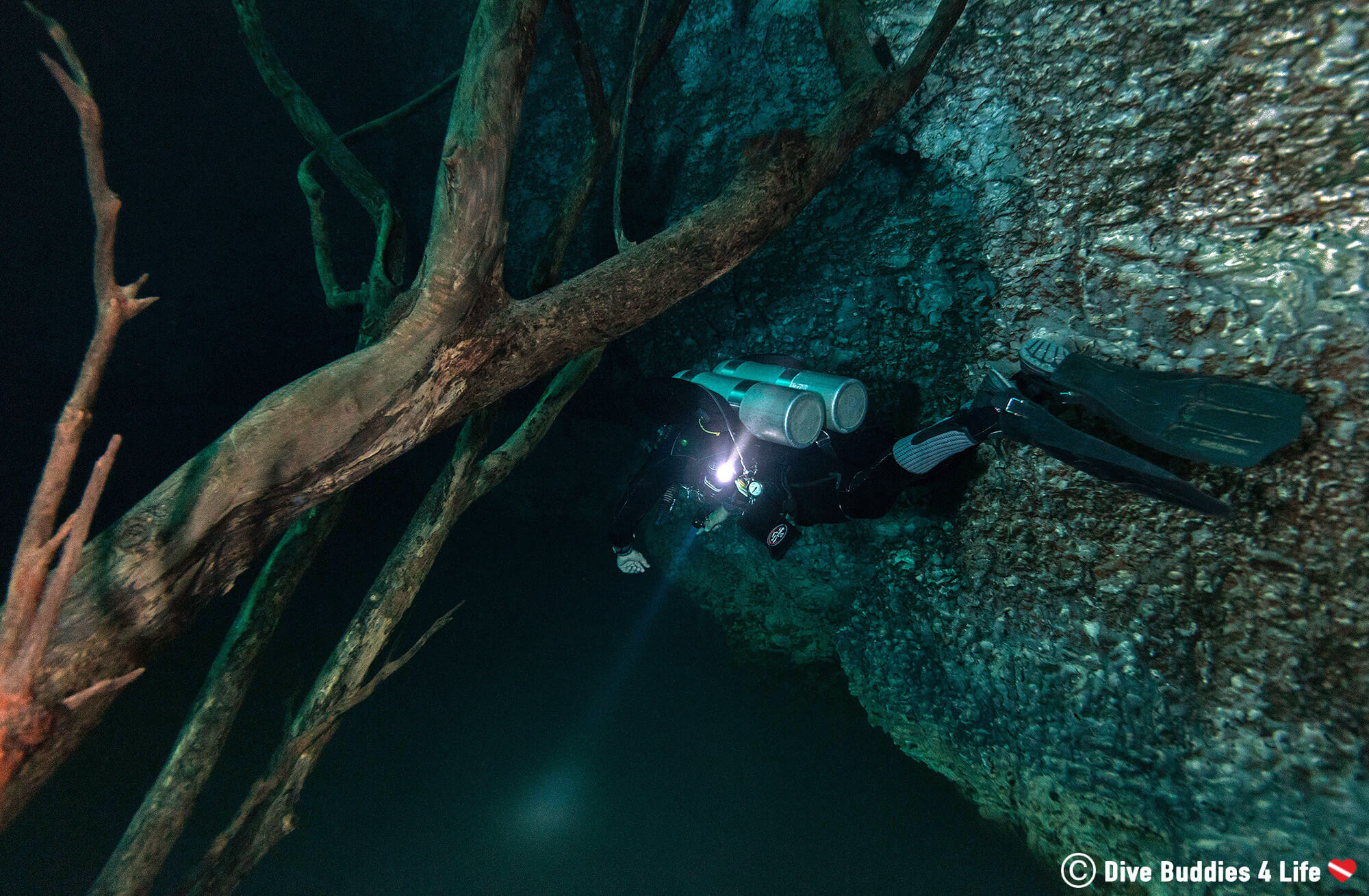
As unsettling as this hydrogen sulfur layer sounds, swimming below this mass was even more perturbing. When sinking beneath the cloud, a diver completely loses sight of their surroundings as they make the transition. It’s disorientating to get that odd-sense of vertigo as you lose track of which way is up and which way is down.
Your senses become heightened as you complete passage through the fog and emerge into dark tea-colored water. The creepiness will sink deep into your bones. Below the hydrogen sulfur layer, your mind and nerves also play tricks on you. As you look away from the cloud into the depths of Angelita, it is possible to see rocky boulders petrified wood. But what is truly amazing is to reach up into the white mass above your head and feel like you are flying in the clouds.
Given the depth of Angelita and our dive profile, our average time underwater was roughly 40-minutes. This time was enough to dive the site as well as experience the surreal hydrogen sulfur cloud.
The second dive, after our dip in Angelita, landed us five minutes from Tulum at Caravela Cenote.
Caravela, also known as the Temple of Doom, was probably one of our favorite cenotes, mainly because of the lucidly clear water which was so transparent, it felt like we were floating like astronauts suspended in space.
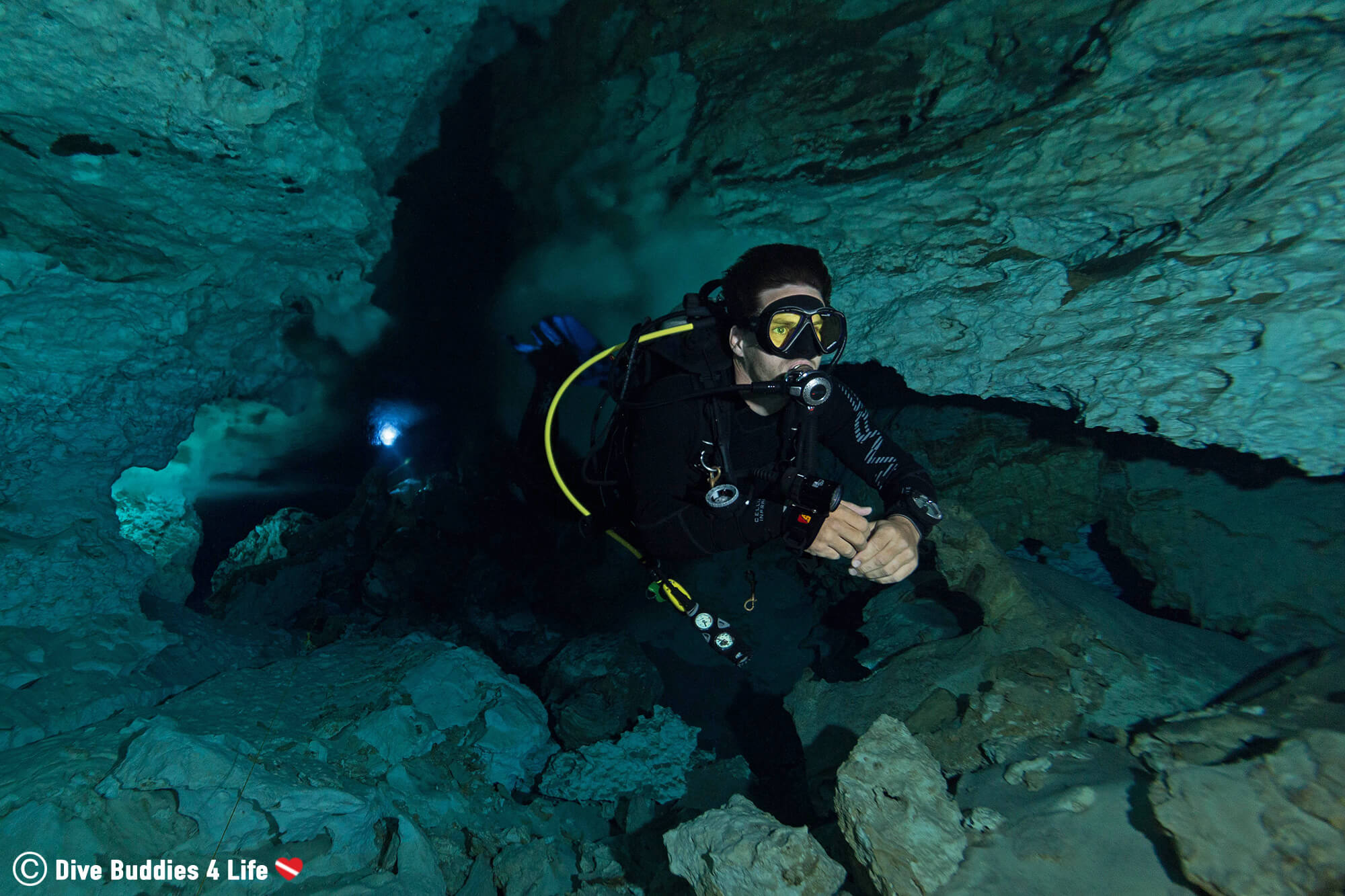
Gear assembled, we proceeded to jump 2.5 meters (8 feet) into the small open pit of the Temple of Doom. I greeted the water giant stride style with a big splash. As we sunk into the subterranean, the sunlight splintered through the blue water in a sparkling haze of beams. It afforded us an optical light show of epic proportions. The view was so striking I spent a good amount of time taking shots of this glitzy wonderland.
Descending into Calavera, the walls of the cave closed in around us, channeling the rays of the sun into a narrow spotlight and leaving the outer extremities of the cave in darkened shadows. Reaching the bottom at 15 meters (50 feet) deep, I turned on my flashlight, the stark white light cutting across the mystical cavern. Finning alongside the preset guideline, I kick past oddly shaped rock formations reminding me of swiss cheese and dozens of arched swim-throughs. Looking at the walls of the cave, the reflection of our dive light enhanced the washed-out brown and orange marble patterns etched within the cave’s geology.
As we swim on, without warning, the once crystal-clear Temple of Doom suddenly becomes a blurry sensation. We had hit a thermocline/halocline gradient where varying water temperatures and freshwater/saltwater meet. Thankfully Joey and I had witnessed this phenomenon on our previous day of diving, and I wasn’t as unnerved as the day before.

Quickly releasing my buoyancy, I let myself sink in the water column, below the distortion, and watch as my husband does the same. Peeking up through the hazy cline, it feels almost as if we are covered by an invisible net, separated from the surface world.

Day three of cenote diving in Tulum, afforded us the marshy lilypads of Carwash Cenote. Getting to the dive site took us about 15 minutes heading from town towards Coba.
As a roadside cenote, Carwash gets its name from the easy-to-access location, where car owners used to be able to conveniently pull up smack dab beside the road and wash their vehicles.
Once onsite, my first impressions of this pit of water were that it was a pool full of tangled plant life. But despite the abundance of weeds that popped up everywhere, Carwash seemed to be a popular swimming hole for locals as well as tourists. There were plenty of families making use of the cenotes clear yet vegetative water.
Donning into our gear and slipping into the water, Carwash was a far cry from the previously visited cenotes. The water was affluent in flora and fauna, and the theme color seemed to be every shade of green imaginable. Dark green lily pads strung up in the water column, lime-green moss carpeting the bottom, and did I mention the medium-sized scaly green crocodile that inhabits the lagoon? Frivolous plant and algal life that seemed to adorn everything.
Interesting Fact: Crocodiles don’t chew their food. Instead, they swallow stones which assist in crushing food in their stomachs and acts as a ballast to balance their bodies.
While there was a lot of distracting activity and sights to be had in Carwash cenote, the entrance to the cave was hard to miss. It was the only circular mouth opening in the whole pond partitioned by a natural barrier.
Wooden tree spears hung down from the glassy surface, and thick snake-like roots protruded up from the covered floor. It gave the transition from pond to underworld a rugged menacing look – like looking into the mouth of some giant undersea monster.
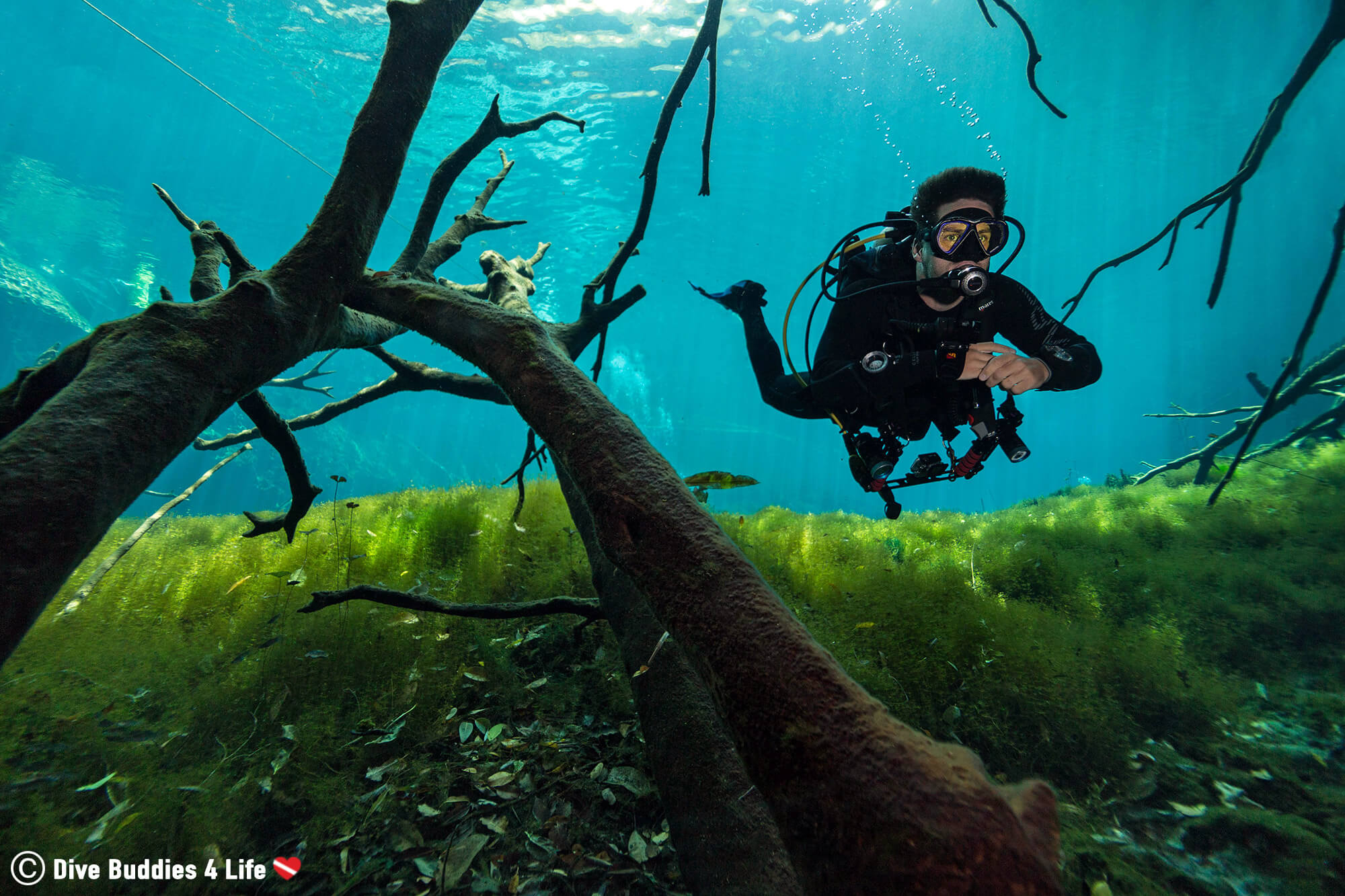
Traveling into the cave, every small noise underwater seemed amplified tenfold. I could almost feel the deep vibrations of our every breath emanating from the walls. Beyond the organic curtain, we followed the guideline down to 15 meters (50 feet) enjoying geology, ancient remains, and my favorite part – the panoramic view of the shallow cave opening painted in a light hue of green.

Our second site was the Tak Be Ha cenote, about 40 minutes driving towards Chetumal. Driving along a winding jungle road, we arrived at a secluded cenote, taking the form of a cave chamber and a semicircle of water.
Suiting up and walking down the cavernous escarpment, we waded out into the chest-deep water before putting on our gear. As much as I expected this cave to resonate much like the previous one, at first glance, Tak Be Ha was much less visually astounding. The underground nature of the cenote, didn’t allow for much light penetration at the surface, resulting in dark shadowed undertones.
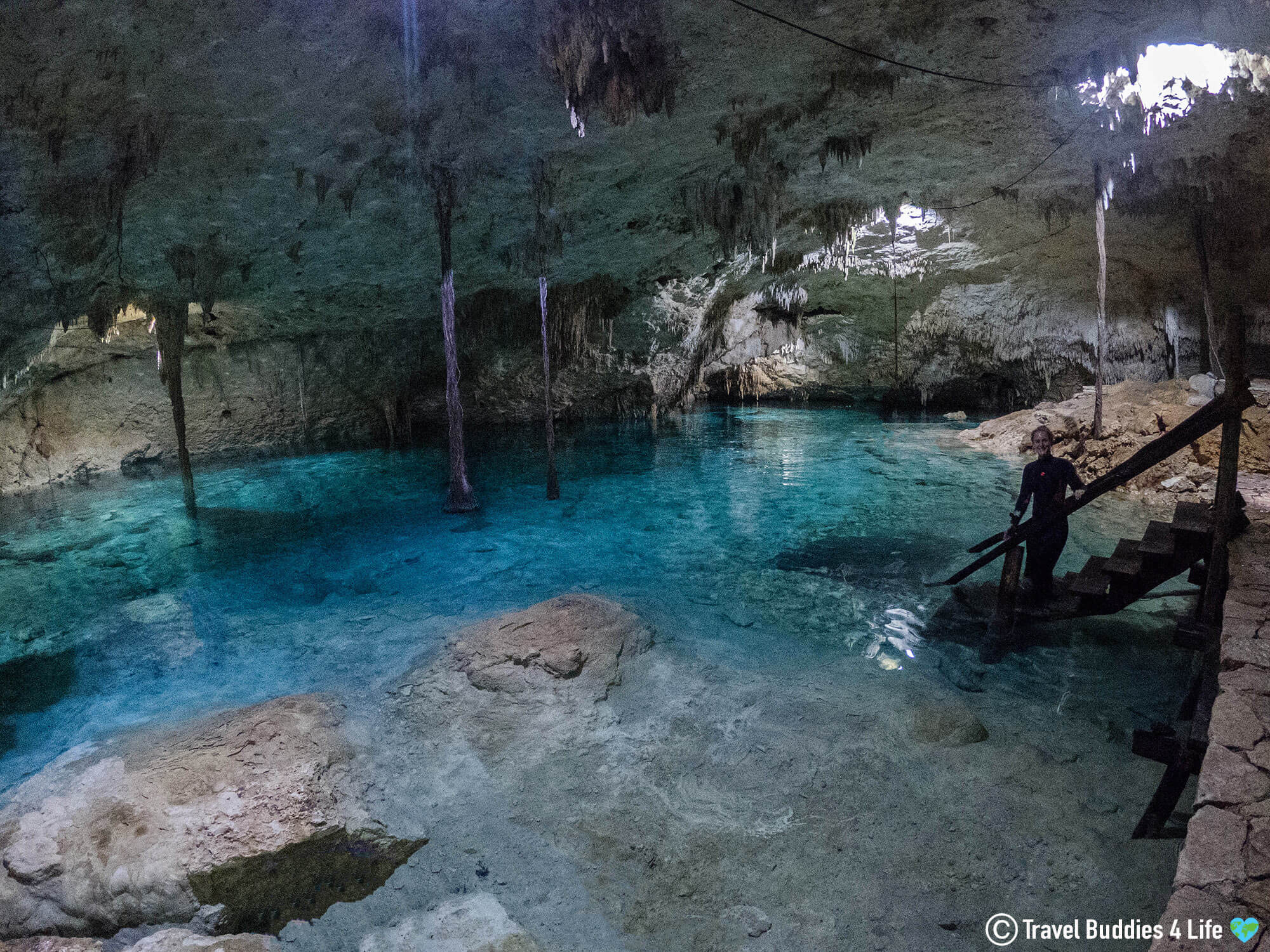
Dive torches switched on in full brightness, we cue behind our guide, swimming past geological formations and rock fissures.
In the moments when we entered into the overhead environment, my initial reservations on the cenote evaporated. Illuminating the cavern roof, my eyes crossed the path with an assortment of stalactites. There were millions of these magnificent geological formations, stretching as far as my dive light would permit me to see. These pointy arrangements made me feel like I was Indiana Jones creeping along a baited room in an ancient temple, trying not to set off the booby-traps.
Being cautious to avoid breaking any of the hanging stalactites, we propelled ourselves further into the twilight zone of the cavern. Still enthralled by the roof, I spotted small air pockets left behind by previous divers. The pockets glistened like silver mercury against the earthy rock tones. I watched as my exhaled bubbles were captured by the roof and guided to these pockets in a large accumulation of air.
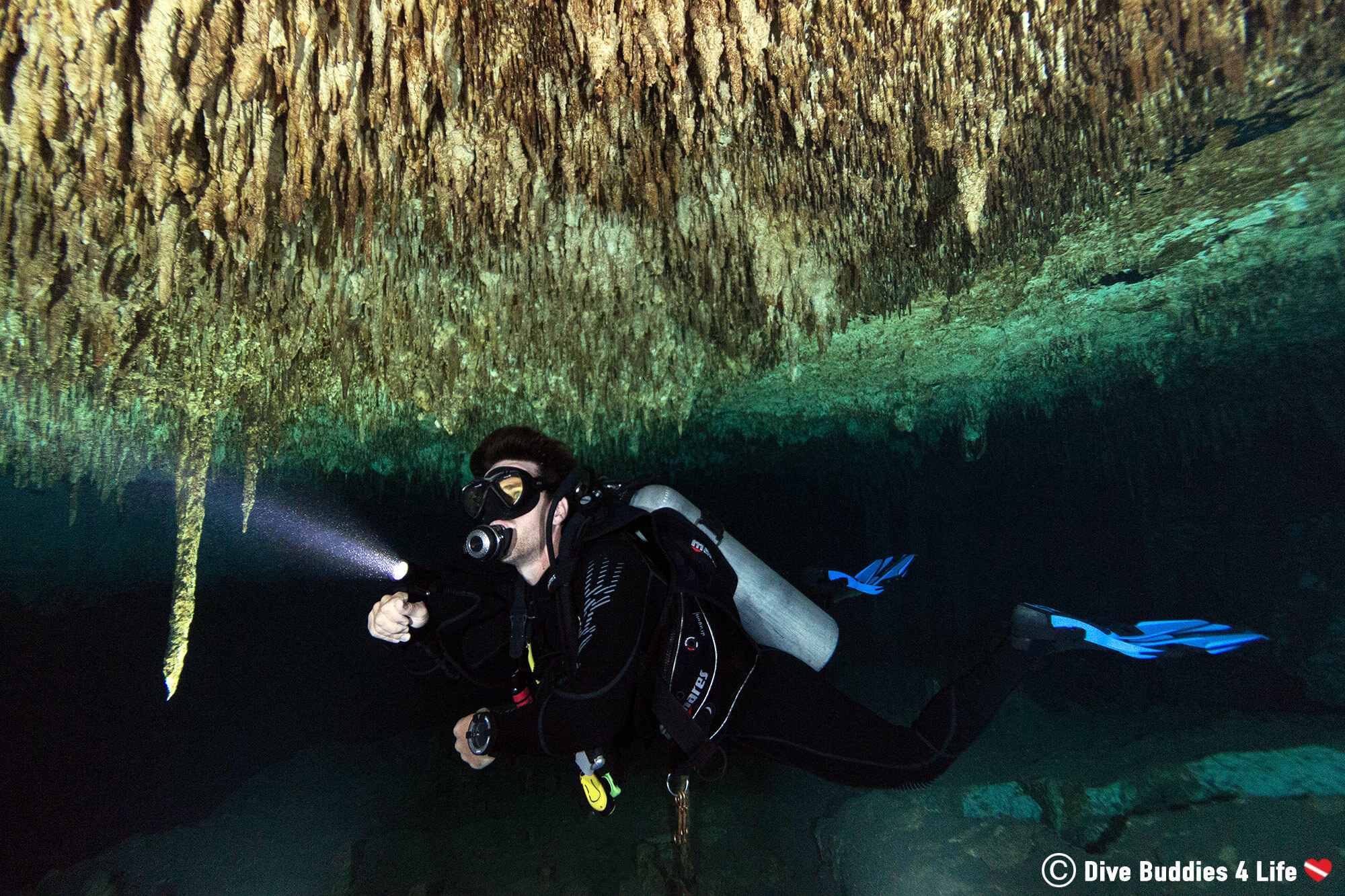
After 3 glorious days underwater, we wrapped up our cavern dives in Tulum with a final dive at Casa Cenote.
Getting to Casa took approximately 10-minute via car, driving 10 kilometers north of Tulum to Tankah Tres Bay. Arriving at the peaceful and exotic lagoon, we were immediately enchanted by the emerald water that seemed to lure us in and flurry of fish swimming just below the surface.
Casa Cenote is best imagined as a river rather than a sinkhole. This wide-open channel of water lays in the middle of a mangrove field and twists and turns over an entire 229 meters (750 foot) length. It also connects to Sistema Sac Aktun (partially Nohoch Nah Chich), one of the longest underwater cave systems in the world, to the ocean.

Submerging into the first channel of Casa, I was immediately surprised by the saltiness of the water. Unlike the other cenotes, which were predominantly freshwater, I could feel – and taste – the bitter sea on my lips.
Taking in my surroundings I enjoy the incredible diversity of life that comes hand in hand with this oceanic cenote. To the left, hundreds of little fish scattered from in front of my mask, seeking refuge in the mangrove roots and fronds that line the shore. To my right, two nickel colored tarpons lurked in the distance near a rocky overhang, watching and waiting to see what we would do next.
Following the curves of the river, we begin our swim through the aquamarine water. Huge rocks overgrown with mosses, and algae peppered the 8 meter (20 foot) deep bottom. Mangroves cascade from the surface, jetting down into the depths. Natural caves burrow through the mangroves giving the impression of swimming beneath the jungle. It was awe-inspiring and a very different experience when compared to all of our other cenotes.

We all dive for different reasons. Some divers like shallow natural reefs, others enjoy deep or technical dives. Some prefer to explore caves, while others choose the sunken treasures of shipwrecks.
In Tulum, Joey and I had the fortunate opportunity to experience cavern diving in some of the most incredible cenotes on the planet. Of the thousands of sinkholes scattered across the Yucatan Peninsula, we explored seven distinct ones. Never would I have imagined such a stark change from our typical ocean diving would captivate my heart in such an unexpected way.
While fish and marine life are the things that once fuelled my love for scuba diving, caverns have pushed me outside of my comfort zone – and in that zone, I have sparked a new and unruly passion.

Have you ever tried sinking into the dark undertones of a cavern or cave in Mexico? What did you think of this style of diving and would you try it again?


The crystal clear water of Ginnie and Devil’s spring systems is arguably some of the best freshwater diving in all of Florida. As a scuba diver heading to the sunshine state, make sure to put this spot on your travel itinerary!
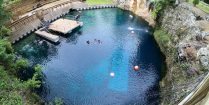
Florida may be known for its ocean coast, but this southern state is also home to some of the best spring and cave systems in the country.
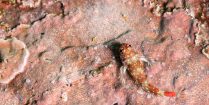
Forget the colorful piñatas and all-you-can-eat tacos, when in Mexico's coastal town of Zihuatanejo, it's all about the scuba diving!
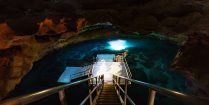
Dark, ancient and mysterious are a few words that can be used to describe the Devil's Den cavern in Florida. Find out what it was like to visit this world-class tourist destination and dive this prehistoric spring system.

Whether your diving with turtles or admiring coral reefs, get ready to be wowed by the underwater beauty of Bonaire, the shore diving capital of the Caribbean.

Submerge yourself into Bonaire's underwater world with this scuba bucket list. It will leave you wanting more from the coral capital of the Caribbean.

Bonaire TEK is an annual October occurrence, where Buddy Dive Resort partners with leaders in the tech diving industry for a week of technical dive demonstrations, equipment trials, presentations, training ins and outs, and camaraderie.

As one of the sunshine states top shore diving destinations, Blue Heron Bridge offers some of the best diving in Florida. Mud, beaches, wrecks and small critters, no matter where you dive under the bridge, there is so much to see, explore and photograph.

Sitting pretty right next to the gulf stream, Jupiter is known as one of Florida's best shark diving location. Drift along in the current as you enjoy an up-close encounter with the ocean's apex predators.

The tropical oasis of Key Largo is a scuba diver's delight. Night dive, reef dives, and wreck dives are all right at your fingertips ready to be explored.

Offering topside beauty and underwater magic, escape to Florida's freshwater springs and snorkel with one of the most majestic marine mammals on the planet.

Situated in the heart of the Caribbean, Cuba has some beautiful diving opportunities.

When in the Florida Keys, make sure to take the time to learn all about man’s quest to explore under the sea at the History of Diving Museum.

Excellent post! I really enjoyed Diving in Cenotes! Thanks for sharing.